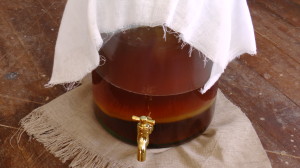It’s taken a while for me to write a post on kombucha as I wanted to get my batches “right” before I posted. I first started making kombucha about six months ago. I purchased a “scoby” online as I didn’t know anyone who made kombucha that I could get a baby scoby from. My first batch was spot on, sweet but tart at the same time and fizzy. Since then I’ve experimented with different teas and sugar and double and triple batches. The method and quantities below are what have worked for me for the nicest brew.
The thing with kombucha though, is you can make it to your individual taste, so you might like it sweeter, fizzier or lighter in colour. The best shop brought kombucha I’ve tasted costs $18 a litre! It’s definitely worth making it, for the constant supply and the reduced $$$. It seems scary to make at first, but trust me it looks harder than it is. If you can afford some tea and sugar you can make this delicious, sparkling, probiotic drink, that I think tastes like a cross between ginger beer and apple cider.
So what is kombucha and how do you pronounce it?
Kombucha is pronounced “kom-boo-cha” and is an antioxidant rich, probiotic drink named interestingly the “Immortal Health Elixir”. It won’t make you immortal, but kombucha is excellent for your digestive health and immune system. This delicious fermented sweetened tea has also been known to improve mood, energy, and the health of your joints, skin, hair, and nails. Most of the sugar in kombucha ferments out, so it has minimal effect on blood sugar.
Kombucha Health Benefits
Like all fermented foods kombucha is rich in enzymes and beneficial bacteria, and contains high levels of antioxidants, b-vitamins, probiotics and glucaric acid. Kombucha hasn’t been known to heal anything specific, but it has been around and consumed for over 2000 years. Studies have reported a variety of health benefits including:
- Improved immune system
- Antioxidant rich
- Increased energy
- Improved digestive function
- Relieves constipation
- Improved circulation
- Balances pH levels
- Relieves arthritis pain
- Reduces blood pressure
- Improves eyesight
- Anti-inflammatory
- Helps liver detoxification
- Improves mood (aids in anxiety/depression)
- Helps nutrient assimilation
- Fights yeast problems
- Relieves stress
- Improves skin and hair quality
- Improves digestive function
- Balances hormone levels
- Decreases allergy symptoms
Personally, I’ve noticed improvements in me and my family’s mood, energy, skin, hair, joint health, and digestion.
What Does Kombucha Taste Like?
Kombucha is slightly tangy and slightly sweet. Like I said before, I think it tastes slightly like ginger beer and a touch of apple cider. Yum! The taste depends on how long it ferments and the fermenting conditions. Longer fermenting periods result in a more vinegary, more carbonated drink. Shorter times will result in a sweeter drink. After the first fermentation, you can bottle and ferment longer for a fizzier drink or you can flavor the kombucha with a number of flavourings like fruit juice, lemon or ginger.
Is Kombucha Safe For Kids?
Kombucha does contain sugar and alcohol in small amounts. Most of the sugar ferments out and if you are concerned about sugar you can ferment longer, over 7 days. The fermentation process produces a small trace amount of alcohol, less than 0.1%.
How Do I Get a SCOBY?
SCOBYs (Symbiotic Colony of Bacteria and Yeast)
are living and thriving colonies of bacteria and yeast working to convert your tea and sugar into kombucha. Scobys are weird looking things and it’s scary to touch them at first, but pretty soon you will be used to handling it. If you can purchase a vessel with a plastic tap like mine, this enables you to handle your scoby as little as possible, keeping it healthy by lowering the risk of contamination. My scoby initially arrived as a perfect little pancake the size of a small mason jar and came in a little pouch of kombucha. With my first batch it soon grew to the size of my kombucha glass vessel with a tap. After the first few batches it started looking a lot weirder. Bits hanging off it, and new baby scobys growing (The first picture shows the small scoby and the next the larger one after a few batches). The scoby has sunk in the second picture, as I had just cleaned out the vessel and removed the “older scoby”. It will float to the top again, though it doesn’t matter if it doesn’t, it’s all good.
There are several ways to obtain a Scoby:
- The most common way is from a friend who already brews kombucha. Ask them for an extra scoby and I’m sure they will be happy to give you one. The scoby feeds, grows and makes a new layer each brew. This “baby” scoby can then be used to brew another batch of kombucha for someone else.
- Or, you can purchase your scoby online and it comes to you either dehydrated or in a pouch filled with sugar tea. Choose a reputable source.
- I’ve heard you can grow your own scoby. I haven’t tried this, but I know others who have, and who have had success with this method. It can be done using a pre-made bottle of raw kombucha that you can get from a health food store. You take a bottle of kombucha and allow it to ferment further which will result in a new baby kombucha scoby. You can find good tutorials online.
How to Brew Kombucha
Make sure your hands and utensils are clean. It is important not to introduce competing bacteria to your brew. Make sure you thoroughly clean and rinse the container and all utensils that will come in contact with the scoby. Only use hot water, not soaps or chemicals.
You Will Need
- 1 Scoby
- 1 cup starter liquid (use a bottle of store brought raw unflavoured kombucha if you don’t have access to anyone’s homemade kombucha)
- 4 tea bags or 2 tablespoons of loose tea (I find tea bags easier). I used normal black tea initially, but for a lighter tea I found that oolong and green tea work really well. Herbal teas contain oils that mess with the scoby so don’t use these.
- 1/2 cup of sugar (I use raw organic cane sugar. I have tried coconut and other sugars but I’ve had the best success with raw organic sugar. Scobys actually find raw and white sugar the easiest to digest). Don’t use honey as its anti-bacterial properties won’t work with the scoby.
- 7 cups of filtered water
Your Utensils
- 1 large glass jar or jar with a plastic spigot (don’t get a metal spigot, you don’t want metal in contact with your brew).
- 1 piece of muslin or other breathable cloth (I used a cheesecloth).
- A rubber band or string to hold the cloth in place.
- If you are using loose leaf tea, you’ll need a stainless steel strainer.
- Airtight bottles (I couldn’t find any clear airtight bottles so I choose dark bottles, you might have better luck where you are).
What To Do
- The night before, clean your glass kombucha vessel well. Place tea and sugar into your mason jar or kombucha vessel. Add hot water and stir until the sugar dissolves. Use hot water not boiling as I’ve had my glass jar crack from the water being too hot. :(. The water should be hot enough to steep the tea. Leave on your counter to cool to room temperature.
- Next morning, when the sugar tea is cool, remove the teabags or tea. If you are using loose tea, pass it through a stainless steel strainer or cheese cloth, making sure no leaves get in your brew.
- Add the scoby and the starter liquid from your kombucha pouch, bottle of unflavoured store brought kombucha, or previous brew vessel.
- Cover the jar with your muslin or cheese cloth and a rubber band or string to allow the mixture to breathe. Do not use an airtight lid.
- Leave to ferment. Choose a warm spot, out of direct sunlight, away from rubbish bins, with good airflow, where your kombucha will be undisturbed.
- Now, the waiting part. I know it’s exciting, but leave your brew for at least 4 days. At day 5, it’s kombucha. Now, have a taste. If it’s too sweet, then leave it longer. I find 6 days is a good amount of time before the second fermentation. In warmer climates kombucha will brew faster, in colder temperatures slower. A bit of experimentation and you will have it to your liking.
- When your kombucha is ready, pour it into sealable bottles. This is where the container with a spigot is handy, but you can use a mason jar and pour off the amount you want to bottle. Leave a small amount in the bottom to start your next batch.
- You can leave it too ferment for a second time in the bottles for 2-3 days. This results in a very fizzy kombucha. You can also flavour it now if you wish before the second ferment. Only add flavour to the bottles, not to your scoby, as this will contaminate it.
- After the second ferment put your kombucha bottles in the fridge as this ceases the fermentation process.
- Pour yourself a nice cool glass of “booch”. 🙂
- Make up some more sugar tea and continue brewing. You can double or triple your batches to suit your family’s needs. If you don’t have a large vessel with a spigot you can make up several batches in glass jars once your scoby has babies.
The first picture below is the brew I made using black tea and the second picture I used oolong tea. The brew in the first picture had a second ferment which resulted in a fizzier drink. Have fun experimenting! 🙂

![kombucha[c]2](https://hermind.org.nz/wp-content/uploads/2015/01/kombuchac2.jpg)
![kombucha[c]2](https://hermind.org.nz/wp-content/uploads/2015/01/kombuchac2-300x168.jpg)




![kombucha[c]3](https://hermind.org.nz/wp-content/uploads/2015/01/kombuchac3-300x168.jpg)





